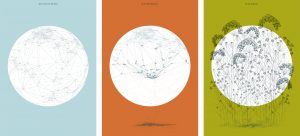Stephanie Posavec describes herself as a self-employed graphic designer
who considers “data” her favored medium. She specializes in data related design and works on data projects that involve language, literature, and science. She has worked on projects and commissions for various companies and institutions that include Facebook, BBC, Tate Britain, and Victoria and Albert Museum. After moving from the United States for her MA in Communication Design in Central Saint Martins, she decided to stay in London to continue her artistic career.
The simplicity of her the Eyeo presentation slides allowed me to easily focus on her works and the messages she delivered through the talk. One of the works that caught my attention both in her talk and her web site was the project she worked on for the Memory Palace exhibition for V&A in London. The push and pull between the objective logical design decisions and the subjective emotional design decisions that occur in the process of working with data is prevalent in this project, as it exemplifies how she works in between the two worlds.
The work consists of three different prints that are simultaneously illustrative and data oriented. Although the illustrative quality initially attracted my attention as the most appealing aspect of the work, the idea behind the artistic choices is what I find more fascinating. Each of the three prints functions as the map of the world, involving accurate data that displays the locations of various capital cities. I admire this project in that it remains true to the data while containing an illustrative quality, just like many other works by Posavec.
In short, I believe that her works go beyond focusing on data visualisation and information design. Using data as a basis to create an illustrative work of art is what I intend to explore in the near future.
Posavec’s world maps for V&A‘s Memory Palace project

![[OLD FALL 2017] 15-104 • Introduction to Computing for Creative Practice](wp-content/uploads/2020/08/stop-banner.png)